Compressed Air Energy Storage Market Research, 2031
The global compressed air energy storage market was valued at $4 billion in 2021, and is projected to reach $31.8 billion by 2031, growing at a CAGR of 23.6% from 2022 to 2031. The technology of compressed air energy storage allows for the large-scale energy storage of compressed air in underground caverns or pressurized storage tanks. After that, a compressor is used to pump compressed air into an enclosure while waiting for the energy to be used. The process of forcing high-pressure air through the atmosphere to produce electricity then makes use of the stored energy that causes the air to expand.
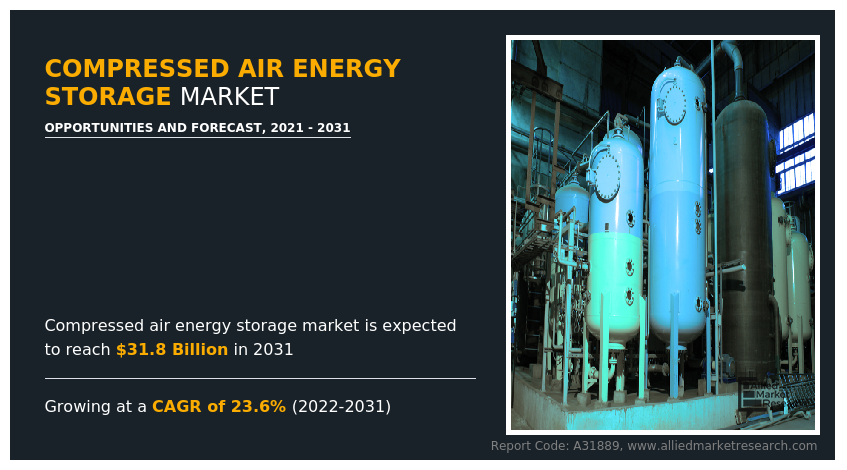
An effective energy storage method called compressed air energy storage (CAES) allows energy to be stored once and then utilized later. Both off-peak and peak load periods can make extensive use of this technology to fulfil the high energy demand. The market size for compressed air energy storage can be linked to CAES systems' capacity to provide efficient and on-demand energy for usage in a variety of sectors, including power generation.
However, it is anticipated that the high cost of establishing compressed air energy storage facilities will limit the market share for compressed air energy storage in the coming years. Complex cooling systems, a high self-discharge rate, and the expensive expense of installing subterranean storage intercoolers for heat dissipation all contribute to the cost of CAES. These factors are anticipated to restrict the global compressed air energy storage market opportunities to some extent.
Globally, there is a growing demand for clean energy that reduces the release of dangerous greenhouse gases. The demand for energy has increased significantly as a result of urbanization and rising world population. The need for infrastructure and power plants has increased because of this. The compressed air energy storage system aids in fulfilling the world's expanding energy needs since it offers unrealized potential for producing sustainable energy. Additionally, compressed air is stored in CAES systems, reducing the need for frequent compressor runs. This prolongs the compressor's useful life and lessens the compressor's general wear. These elements are expected to produce fantastic chances to accelerate compressed air energy storage market size in the coming years.
The key players profiled in this report include Siemens Energy AG, General Compression Ltd (GCL), Hydrostor Inc., Bright Energy Storage Technologies, Pacific Gas and Electric Company, Apex Compressed Air Energy Storage, LLC, Ridge Energy Storage and Grid Services LP, ALACAES, Storelectric Limited, and LightSail Energy.
The global compressed air energy storage market is segmented on the basis of method, storage, application, end-use industry and region. By method, the market is sub-segmented into diabatic, adiabatic and isothermal. On the basis of storage, the CAES market is bifurcated into traditional CAES storage and liquid gas CAES storage. By application, the market is classified into energy management, backup and seasonal reserves, and renewable integration. End-use industry is divided into power station, distributed energy system and automotive power. By region, the market is analyzed across North America, Europe, Asia-Pacific, and LAMEA.
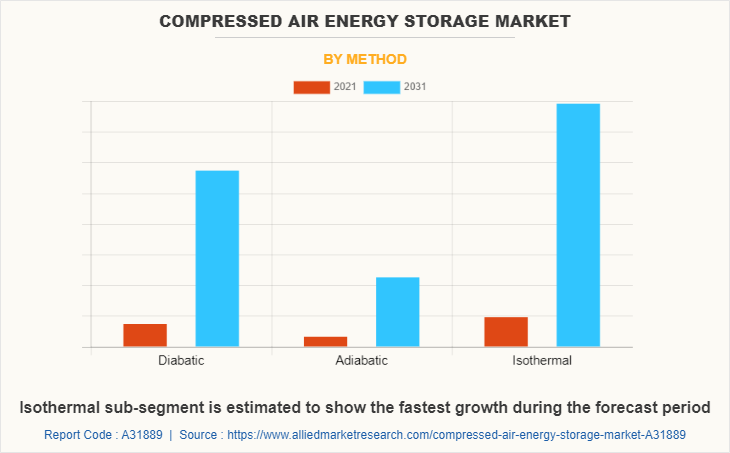
By method, in 2021, the isothermal method accounted for the largest market share. A developing technology that aids in resolving the issues with conventional diabatic and adiabatic methods of compressed air energy storage is the isothermal approach. One of the advantages of CAES is that it permits two times as much air compression as adiabatic CAES. As a result, the cost of the CAES system is around one-seventh less than it would be using typical CAES procedures. Additionally, it is anticipated that isothermal CAES has a theoretical round-trip efficiency limit of 80% and a practical limit of 100%. When compared to diabatic and adiabatic CAES approaches, this is higher. During the forecast period, these factors are anticipated to produce advantageous prospects for the isothermal CAES approach.
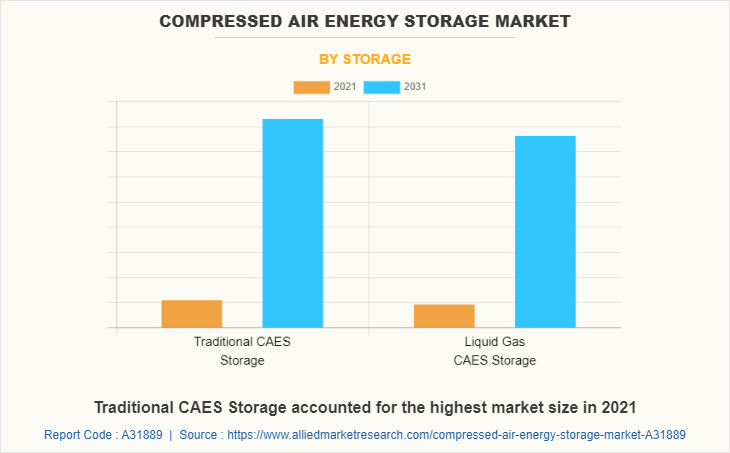
The compressed air energy storage industry's traditional CAES storage subsegment is expected to have the largest market in 2021. Due to its affordability and dependability, the conventional CAES storage technology is popular. In this type of storage, sizable underground enclosed caves are used to store compressed air. The classic CAES approach has a high operational effectiveness, which accounts for its widespread use. These elements are anticipated to fuel the traditional CAES storage's growth in the ensuing years.
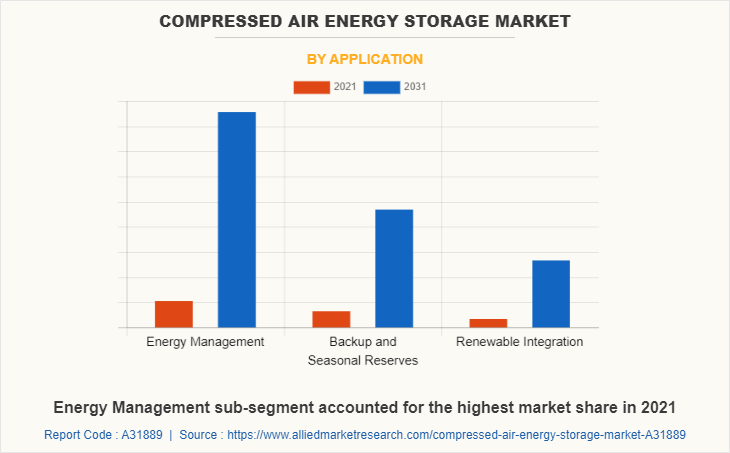
By application, the energy management sub-segment dominated the global compressed air energy storage market share in 2021. Energy management is the process of tracking and optimizing energy consumption in order to reduce energy consumption in a building. There are a few steps to the energy management process: Continuous data collection and analysis: finding ways to improve energy efficiency by optimizing equipment schedules and setting points, and flow rates. Renewable energy sources can be employed with flexible energy systems provided by CAES systems for energy management. Systems for compressed air energy storage are dependable and easily accessible, and they can provide the increased energy needs of the energy management industry. These facilities may also accommodate the fluctuating volume, pressure, and storage requirements of the energy management industry.
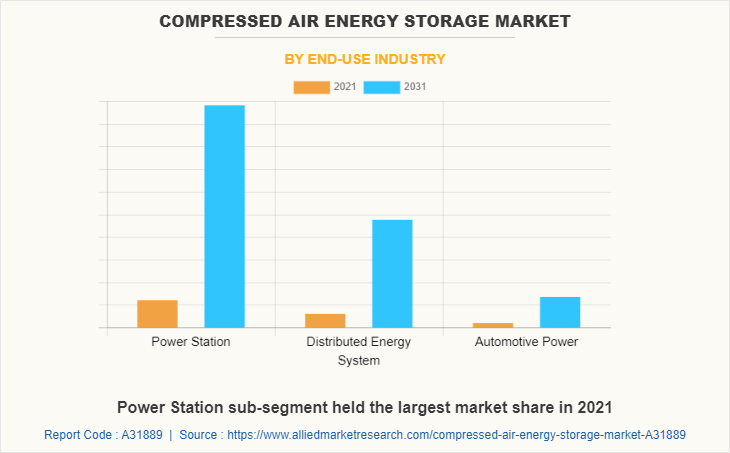
By end-use industry, the energy management sub-segment dominated the global compressed air energy storage market share in 2021. The market for compressed air energy storage has enormous potential for application in power plants to lessen the reliance on fossil-fuel based energy. The CAES can be utilized at large power plants for a variety of purposes, including peak shaving, load shifting, voltage control, and frequency control. It can be used to produce power steadily at renewable energy facilities like wind turbines. In the approaching years, it is projected that these factors would increase the market share of power plants.
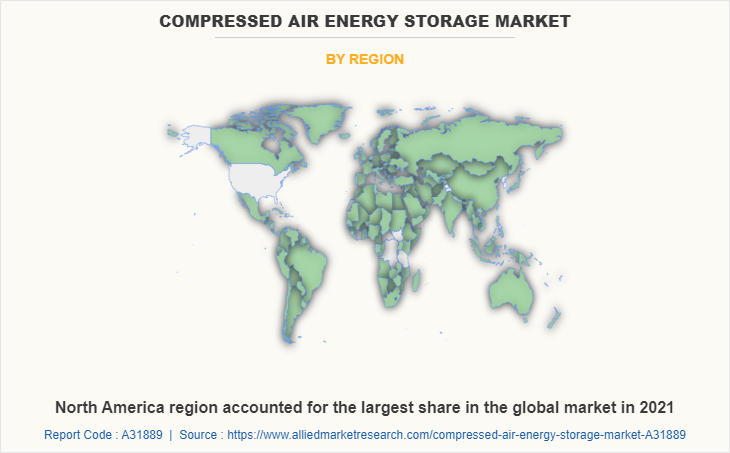
By region, Asia-Pacific is anticipated to grow at the fastest CAGR during the projected time frame. This is majorly owing to countries such as India, China, Japan, and other Asia-Pacific nations that are continuously assessing practical energy generating and storage technologies to meet long-term climate sustainability goals. The largest 100 MW advanced CAES plant in the world, which is prepared to begin commercial operations, was connected to China's power generation system in September 2022. This plant, designed by China's Institute of Engineering Thermophysics (IET), has a capacity of more than 132 million kWh. The compressed air energy storage market possibilities in the Asia-Pacific region are predicted to benefit from these aspects.
Impact of COVID-19 on the Global Compressed Air Energy Storage Industry
- Sales of compressed air energy storage were negatively impacted by the abrupt COVID-19 pandemic outbreak, largely as a result of the strict lockdown measures implemented by governments around the world, such as complete lock down
- Energy storage project development has been delayed as a result of supply chain disruptions. which in turn has had an impact on the current growth in energy demand.
Key Benefits For Stakeholders
- The report provides exclusive and comprehensive analysis of the global compressed air energy storage market trends along with the compressed air energy storage market forecast
- The report elucidates the compressed air energy storage market opportunity along with key drivers, and restraints of the market. It is a compilation of detailed information, inputs from industry participants and industry experts across the value chain, and quantitative and qualitative assessment by industry analysts
- Porter’s five forces analysis helps analyze the potential of the buyers & suppliers and the competitive scenario of the market for strategy building
- The report entailing the compressed air energy storage market analysis maps the qualitative sway of various industry factors on market segments as well as geographies.
- The data in this report aims on market dynamics, trends, and developments affecting the compressed air energy storage market growth
Compressed Air Energy Storage Market Report Highlights
| Aspects | Details |
| Market Size By 2031 | USD 31.8 billion |
| Growth Rate | CAGR of 23.6% |
| Forecast period | 2021 - 2031 |
| Report Pages | 220 |
| By Method |
|
| By Storage |
|
| By Application |
|
| By End-use Industry |
|
| By Region |
|
| Key Market Players | Pacific Gas and Electric Company, Apex Compressed Air Energy Storage, LLC, Bright Energy Storage Technologies, Ridge Energy Storage and Grid Services LP, Storelectric Limited, Hydrostor Inc., Siemens Energy AG, General Compression Ltd (GCL), ALACAES, LightSail Energy |
Analyst Review
CAES is a strategy for storing electrical energy generated during periods of excess supply and making it accessible once more during periods of high demand. In a CAES system, compressed air is stored in enclosed underground caverns and is back-produced as needed using energy recovered in a gas turbine. The potential of these systems to provide greater energy storage to fulfil the electricity demand during peak load is a key factor driving the compressed air energy storage market. For 40 years, this technology has been around. The CAES technology is a tried-and-true technology that provides a dependable and efficient energy storage solution, and it can be easily customized for particular site conditions. As it reduces harmful carbon emissions and the reliance on fossil fuel-based energy, CAES aids in the achievement of the carbon neutrality targets. CAES serves to improve the stability of the power grid and lessens the load on electrical infrastructure. During the forecast period, these factors are projected to create tremendous prospects in the compressed air energy storage market. The high capital investment required in compressed air energy storage infrastructure is a critical market restraint.
Among the analyzed regions, North America accounted for the highest revenue in the market by 2031, the main factor boosting the development of the target industry in North America is CAES helps in reducing the carbon emissions and nullifying it.
Compressed air energy storage offers excellent energy savings during peak usage that can meet the high energy demand during the peak load period which are the upcoming trends in the market.
Energy management is the leading application of the compressed air energy storage market.
North America is the largest regional market for the compressed air energy storage market.
The compressed air energy storage market is anticipated to reach $31,827.7 million by 2031.
Siemens Energy AG, General Compression Ltd (GCL), and Hydrostor Inc. are the leading companies to hold the highest share in the market.
Loading Table Of Content...


